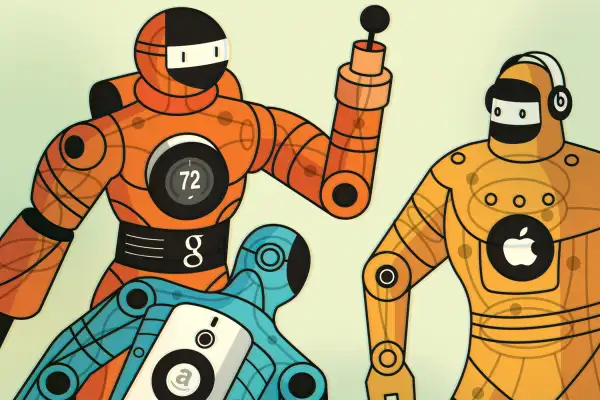Apple, Amazon, or Google: Who Will Win the Battle of the Tech Titans?
Money is not a client of any investment adviser featured on this page. The information provided on this page is for educational purposes only and is not intended as investment advice. Money does not offer advisory services.

The blueprint for success in technology used to be straightforward: Develop a cutting-edge product people need; build a (near) monopoly; then reap the rewards of controlling that technology—be it the software or chips that make computers run or the switches that make the Internet possible. That was how Microsoft, Intel, and Cisco Systems ruled the ’90s.
Fifteen years after the first great tech stock boom ended, the industry’s new colossal trio of Apple, Google, and Amazon couldn’t be more different from their ancestors.
They’ve created vast arrays of products, from mobile devices to streaming services to payment systems, which they tie together in various ways to support their core revenue stream. Think not of solitary giants, but of giant ecosystems. And those systems, not the latest iPhone or Google Glass or Kindle, are “the defining characteristic of the company,” says Robert Stimpson, co-manager of the White Oak Select Growth Fund.
That means evaluating the strength of those ecosystems is what a tech stock investor has to do. To help, Money consulted some of the smartest analysts in the business for guidance and took a hard look at the valuations investors are placing on those systems today.
Apple: Elegant Hardware and Cash to Spare
The heart of the ecosystem: More than 90% of Apple’s $183 billion in revenue in its latest fiscal year came from hardware sales—56% from iPhone sales alone.
Fuel for growth: Hardware is what Apple sells, but it’s not what the company markets. “Apple’s main product is an experience,” says tech analyst Neil Cybart. “They look at all of their products as taking away the complicated part of technology so the users can feel like they have more control over their lives.”
Apple aims to build a world in which you’ll own Beats by Dr. Dre headphones, wear an Apple Watch, buy coffee with the Apple Pay payments system, and make hands-free phone calls via Apple CarPlay. With all those products interlinked and running on Apple’s iOS software, you’ll rely on the ecosystem for daily tasks, making it a hassle for you to buy your next phone or tablet from anyone other than Apple.
Potential threats: Apple has a hit with the iPhone 6 and 6 Plus, selling an estimated 60 million of the phones last year. Indeed, as TIME recently reported, the iPhone 6's success has cut into Android's smartphone market share in the U.S. for the first time since September 2013.
But the company isn’t particularly good at enticing the owner of one Apple product to purchase another, says Consumer Intelligence Research Partners’ Michael Levin.
For instance, only 28% of iPhone owners have an Apple computer, and less than half of them own a tablet, says CIRP. Sales for the iPad have fallen 4% over the past year, acknowledges Apple. But CEO Tim Cook, noting that the company has sold 237 million iPads over four years, told investors in October that he’s “very bullish on where we can take the iPad over time.”
Outlook: BUY
Apple enjoyed a banner year in 2014. Spurred by sales of the latest iterations of the iPhone and anticipation of the Apple Watch’s release in March, the company’s stock rose 40%.
Despite that gain, Apple’s price/earnings ratio, based on projected profits, is just 13.8. That means the stock trades at a 16% discount to the S&P 500 technology index, even though the company’s earnings are growing 33% faster than the average big tech stock’s.
Apple’s low valuation stems from factors such as investors’ doubts that a company its size can grow as fast as smaller tech firms, along with uncertainty that Apple will keep making products that are both popular and profitable.
That said, Apple is still the best company by far at creating exciting technology that people want to buy. Plus, signs point to an ever-increasing dividend from the stock, which now yields 1.8%; a larger payout can be easily covered by Apple’s $155 billion cash reserves.
Amazon.com: Sales Grow, but Earnings Are Scarce
The heart of the ecosystem: Already the world’s biggest online retailer, racking up $85 billion in annual sales, Amazon aims to catch up to the world champion, Wal-Mart, which has just under half a trillion in revenue.
To close that gap, Amazon wants to convert more customers to Amazon Prime, the two-day shipping service now priced at $99 per year. Amazon Prime members make twice as many purchases as nonmembers, and they spend 40% more per transaction, reports ComScore. Prime customers are also loyal: 92% say they’ll renew their subscriptions.
Fuel for growth: To get more people to join Amazon Prime—and buy more goods per year—Amazon has morphed into a streaming-media and mobile-device company.
In 2011 the e-tailer began offering Prime members access to instant streaming movies and television shows; the retailer now produces its own TV programs as well. To sweeten Prime, Amazon recently added a streaming-music service and free online photo backups. Plus, when the company launched its Fire smartphone last year, a one-year Prime membership came bundled free with the device.
The result: There are now an estimated 30 million Prime members, up from around 5 million in 2011.
Potential threats: Amazon has spent heavily on the entertainment it’s using to lure new Prime sign-ups. The company has posted cumulative losses of more than $350 million over the past 10 quarters—vs. the $94 billion in profits Apple churned out. Amazon CEO Jeff Bezos is unapologetic; last year, he reprinted a 1997 letter to shareholders saying that “long-term market leadership” was more important than “short-term profitability.”
One hit to profitability has been the Fire phone. While 10 million iPhone 6’s were purchased the first weekend they went on sale, Amazon reportedly sold only 35,000 of its smartphones in the first month. Late last year the company took a $170 million charge stemming from the fiasco.
Amazon is learning a hard lesson. It may be a hot retail brand—but not when it comes to cutting-edge technology. “There are people who say, ‘I’m an Apple guy,’ ” says Kevin Landis, a longtime tech investor who runs the Firsthand Technology Opportunities Fund. “I haven’t heard anyone say, ‘I’m an Amazon guy.’ ”
Outlook: SELL
Despite losing a quarter of their value last year, Amazon shares still trade at a whopping P/E of nearly 100, owing to the fact that the company is barely profitable. And even if Amazon cuts costs, problems are likely to persist.
While traditional technology companies enjoy big profit margins, retailers like Amazon don’t, notes Christopher Baggini, a portfolio manager at Turner Investments. Amazon’s operating profit margin has historically been in the low single digits, compared with 20% to 30% for Apple and Google. That means even if Amazon stops spending on losers like the Fire phone, it won’t have Apple and Google’s resources to keep building out its ecosystem.
Google: Helped and Hindered by an Open System
The heart of the ecosystem: Given Google’s driverless cars, Internet-connected glasses, and smartphone-linked Nest thermostat, you might think this company was all about the future.
Actually, a lot of what Google is working on is meant to reinforce the past: the company’s roots as a search engine reaping ad dollars based on what people look for online. Advertising still generates about 80% of the company’s $64 billion in annual revenues.
Fuel for growth: The Android operating system, which Google launched in 2007, is essential for protecting its search franchise.
Well before the rise of smartphones, Google management foresaw that the biggest threat to its business wouldn’t be a rival search engine, says Connor Browne, manager of the Thornburg Value Fund. Rather, he says, the company saw that danger lay in adoption of new hardware: As people shifted from PCs to mobile devices, manufacturers could conceivably eliminate Google’s technology from their products.
Android was the company’s defense against gatekeepers like Apple. While Google doesn’t make much money off the software, Android puts the company’s search technology at the fingertips—or voice control—of more than 1 billion people.
For further revenue growth, Google may have to rely on rival Apple’s stronger talents for setting technology trends. Just as Apple’s marketing efforts for the iPhone and iPad created whole new markets for smartphones and tablets, the Apple Watch, scheduled for release in March, could bring wearable devices into the mainstream. Android-based watches came on the market last year, but Apple’s introduction could spark sales industrywide.
The situation is similar for Google Wallet, the electronic-payment platform that has found less traction in its first three years than Apple Pay did in its first three months. “Google will benefit from Apple making headway in creating a walletless society,” says White Oak’s Stimpson, whose fund owns Google shares.
E-payments are actually more central to Google’s core ad business than to Apple’s success. If you’re watching a video on Google-owned YouTube, for example, companies can run messages tailored to your interests. It would be a natural step—and also seamless—for you to buy an advertised item via Google Wallet.
Potential threats: Start with Android itself. Unlike Apple’s iOS operating system, Android is open source, meaning that Google’s “partners” can tweak it. When Amazon built its Android-based Fire phone last year, it stripped out Gmail and Google Play Store. Fire phones and Kindle tablets link instead to the Amazon Appstore, which competes with Google Play and iTunes.
Similarly, Google can’t dictate which version of Android hardware makers employ. Google Wallet’s convenient “tap and pay” function, for example, requires versions of the operating system that are installed on only 34% of Android phones.
Google also faces threats from other major players. The Chinese e-commerce giant Alibaba, for one, has developed its own smartphone operating system, which could cut into Android’s 80% share of mobile devices in China.
Google executive chairman Eric Schmidt acknowledges the company faces threats known and unknown. “Someone, somewhere in a garage is gunning for us,” he said in an October speech. “I know, because not long ago we were in that garage.”
Outlook: HOLD
As Google’s earnings growth rate has declined, so too has its P/E ratio—from around 25 last year to 18. That means Google stock is 25% cheaper than the average for Internet companies in the S&P 500, even though it’s traditionally been on par.
Paul Meeks, a portfolio manager at Saturna Capital, which owns the stock, notes that there may be more rockiness ahead, as Google keeps reporting lower ad prices. Once that stabilizes, he says, the stock should start to rebound, just as you’d expect any sound ecosystem to recover from a minor disturbance.
In both cases, though, the healing takes time.
See all of the 2015 Investor's Guide

